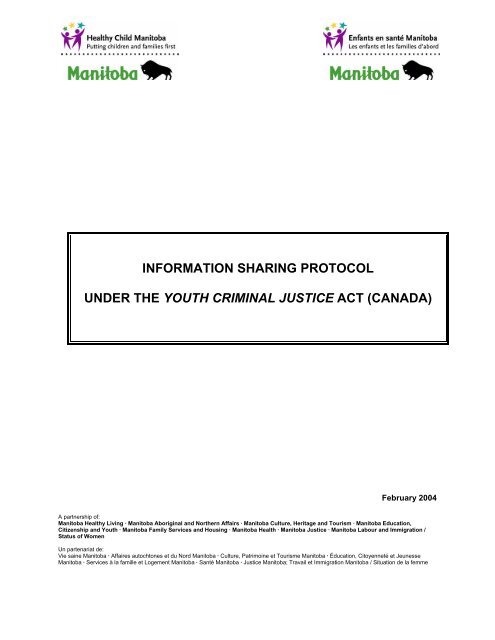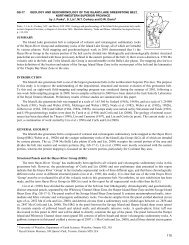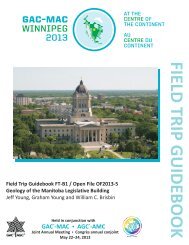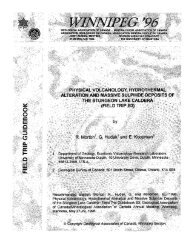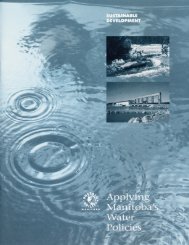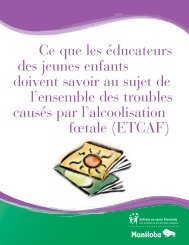information sharing protocol under the youth criminal justice act
information sharing protocol under the youth criminal justice act
information sharing protocol under the youth criminal justice act
You also want an ePaper? Increase the reach of your titles
YUMPU automatically turns print PDFs into web optimized ePapers that Google loves.
INFORMATION SHARING PROTOCOLUNDER THE YOUTH CRIMINAL JUSTICE ACT (CANADA)February 2004A partnership of:Manitoba Healthy Living · Manitoba Aboriginal and Nor<strong>the</strong>rn Affairs · Manitoba Culture, Heritage and Tourism · Manitoba Education,Citizenship and Youth · Manitoba Family Services and Housing · Manitoba Health · Manitoba Justice · Manitoba Labour and Immigration /Status of WomenUn partenariat de:Vie saine Manitoba · Affaires autochtones et du Nord Manitoba · Culture, Patrimoine et Tourisme Manitoba · Éducation, Citoyenneté et JeunesseManitoba · Services à la famille et Logement Manitoba · Santé Manitoba · Justice Manitoba; Travail et Immigration Manitoba / Situation de la femme
INFORMATION SHARING PROTOCOLUNDER THE YOUTH CRIMINAL JUSTICE ACT (CANADA)forTHE SHARING OF YOUTH CRIMINAL JUSTICE INFORMATIONWITH MANITOBA SCHOOLS BY MANITOBA JUSTICE ANDPOLICE OFFICERSFEBRUARY 2004Manitoba JusticeManitoba Education, Citizenship and Youth2
TABLE OF CONTENTSLEGISLATIVE AUTHORITY TO DISCLOSE INFORMATION TO SCHOOLS .......................................4PREAMBLE..............................................................................................................................................4GUIDING PRINCIPLES............................................................................................................................6GUIDELINES AND PROCEDURES ........................................................................................................6DEFINITIONS...........................................................................................................................................6INFORMATION THAT MAY BE DISCLOSED TO A SCHOOL ...............................................................................7WHO MAY DISCLOSE THE INFORMATION TO A SCHOOL ...............................................................................7WHO MAY THE INFORMATION BE DISCLOSED TO ........................................................................................7WHEN MAY THE INFORMATION BE DISCLOSED ...........................................................................................8RESPONSIBILITIES OF THE SCHOOL AND THE SCHOOL REPRESENTATIVE...................................................10STORAGE OF INFORMATION ...................................................................................................................12STUDENTS LEAVING SCHOOL .................................................................................................................12DESTRUCTION OF INFORMATION ............................................................................................................13DISPUTE RESOLUTION MECHANISM .......................................................................................................13APPENDIX 1 POLICE NOTIFICATION TO SCHOOLS FOR PROMISE TO APPEAR ORRECOGNIZANCE .......................................................................................................................................15APPENDIX 2 - TIME LIMITS FOR DISCLOSURE .....................................................................................17APPENDIX 3 - PENALTIES FOR UNAUTHORIZED DISCLOSURE OF INFORMATION.........................18APPENDIX 4 - FREQUENTLY ASKED QUESTIONS................................................................................19For more <strong>information</strong> cont<strong>act</strong>:Your School Division SuperintendentManitoba Justice – Provincial Director for YCJA: 945-7890Manitoba Education Administration Services: 945- 68993
INFORMATION SHARING PROTOCOLUNDER THE YOUTH CRIMINAL JUSTICE ACT(CANADA)forTHE SHARING OF YOUTH CRIMINAL JUSTICEINFORMATION WITH MANITOBA SCHOOLS BYMANITOBA JUSTICE ANDPOLICE OFFICERSLEGISLATIVE AUTHORITY TO DISCLOSE INFORMATION TO SCHOOLSSubsection 125(6) of <strong>the</strong> Youth Criminal Justice Act authorizes <strong>the</strong> limited disclosure of<strong>information</strong> respecting young persons dealt with <strong>under</strong> that Act to school “representatives”.125(6) The provincial director, a <strong>youth</strong> worker, <strong>the</strong> Attorney General, a peace officer orany o<strong>the</strong>r person engaged in <strong>the</strong> provision of services to young persons may disclose toany professional or o<strong>the</strong>r person engaged in <strong>the</strong> supervision or care of a young person –including <strong>the</strong> representative of any school board or school or any o<strong>the</strong>r educational ortraining institution – any <strong>information</strong> contained in a record kept <strong>under</strong> sections 114 to116 if <strong>the</strong> disclosure is necessary(a) to ensure compliance by <strong>the</strong> young person with an authorization <strong>under</strong> section 91[for reintegration leave or day release] or an order of <strong>the</strong> <strong>youth</strong> <strong>justice</strong> court;(b) to ensure <strong>the</strong> safety of staff, students or o<strong>the</strong>r persons; or(c) to facilitate <strong>the</strong> rehabilitation of <strong>the</strong> young person.PREAMBLEThe federal Youth Criminal Justice Act (<strong>the</strong> “YCJA”) replaces <strong>the</strong> Young Offenders Act andcame into effect on April 1, 2003. The term “young person” is used in <strong>the</strong> Youth CriminalJustice Act ra<strong>the</strong>r than <strong>the</strong> term “young offender”.Part 6 of <strong>the</strong> Youth Criminal Justice Act (sections 110 to 129) deals with records and <strong>information</strong>about young persons who have been dealt with <strong>under</strong> <strong>the</strong> Act. In particular:• sections 114 to 116 describe <strong>the</strong> records which may be kept about a youngperson dealt with <strong>under</strong> <strong>the</strong> Youth Criminal Justice Act by a <strong>youth</strong> <strong>justice</strong> court,review board or any o<strong>the</strong>r court, by a police force or by a department or agencyof a government in Canada, such as Manitoba Justice;• sections 117 to 124 set out who may have access to <strong>the</strong>se court, police andgovernment records, and <strong>under</strong> what conditions. Subsection 119(2) containstime limits after which <strong>information</strong> about a young person cannot be disclosed (<strong>the</strong>“period of access”);
• Sections 125 to 127 permit disclosure of <strong>information</strong> in records kept <strong>under</strong> <strong>the</strong>Act by <strong>the</strong> Attorney General of Manitoba, <strong>the</strong> provincial director, <strong>youth</strong> workers,peace officers and o<strong>the</strong>r persons engaged in providing services to youngpersons to certain persons in specified circumstances. Subsection 125(6)permits disclosure of such <strong>information</strong> for specific purposes to “a representativeof any school board or school or any o<strong>the</strong>r educational or training institution”, aswell as to any professional or o<strong>the</strong>r person engaged in <strong>the</strong> supervision or care of<strong>the</strong> young person for certain specified purposes;• Subsection 125(7) and section 128 deal with how <strong>information</strong> provided <strong>under</strong> <strong>the</strong>Act is to be protected, shared, stored and destroyed by persons, such as schoolrepresentatives, who have received <strong>the</strong> <strong>information</strong>; and• Section 129 restricts fur<strong>the</strong>r disclosure of records and <strong>information</strong> by persons,such as school representatives, who have been given access to <strong>information</strong>, orto whom <strong>information</strong> has been disclosed, <strong>under</strong> <strong>the</strong> Act.This Protocol was developed jointly by Manitoba Justice, Manitoba Education, Citizenship andYouth and stakeholder groups including police services, school trustees and senior schooladministrators. It provides guidelines for <strong>the</strong> disclosure of <strong>information</strong> about young personswho have been dealt with <strong>under</strong> <strong>the</strong> Youth Criminal Justice Act, or <strong>the</strong> Young Offenders Act, toschools and how schools must protect and deal with this <strong>information</strong>.This Protocol is intended to:• describe Manitoba Justice's responsibilities and procedures for <strong>the</strong> disclosure andsecurity of such <strong>information</strong>;• make possible <strong>the</strong> exchange of <strong>information</strong> necessary to:‣ make sure young persons comply with Youth Justice Court orders (including ordersof probation and supervision) and with temporary leave authorizations,‣ provide for <strong>the</strong> safety of students, staff and o<strong>the</strong>r persons, and‣ carry out programs of rehabilitation for young persons;• assist schools in developing <strong>the</strong>ir own policies and procedures for use of, access to,fur<strong>the</strong>r disclosure, security, storage and destruction of shared <strong>information</strong>, includingpolicies and procedures:‣ for <strong>sharing</strong> <strong>information</strong> about young persons dealt with <strong>under</strong> <strong>the</strong> Act which willensure that <strong>the</strong> balance between <strong>the</strong> need to know and <strong>the</strong> privacy rights of youngpersons <strong>under</strong> <strong>the</strong> Act is maintained,‣ about <strong>the</strong> restrictions on subsequent disclosure and <strong>sharing</strong> of <strong>information</strong> aboutyoung persons dealt with <strong>under</strong> <strong>the</strong> Act, and‣ for <strong>the</strong> security and destruction of <strong>information</strong> about young persons dealt with <strong>under</strong><strong>the</strong> Act;5
• ensure that staff of Manitoba Justice, police officers and school officials are aware of<strong>the</strong>ir respective responsibilities <strong>under</strong> <strong>the</strong> Youth Criminal Justice Act.GUIDING PRINCIPLES• Crime prevention amongst young persons is essential to <strong>the</strong> long-term protection ofsociety. The ultimate goal is to <strong>act</strong> in <strong>the</strong> best interests of <strong>the</strong> young person, throughearly identification, prevention and rehabilitation, while at <strong>the</strong> same time ensuring <strong>the</strong>safety of society.• Protection of society, a primary objective of <strong>the</strong> <strong>criminal</strong> law applicable to young persons,is best served by rehabilitation. Rehabilitation is best achieved by addressing <strong>the</strong> needsand circumstances of <strong>the</strong> young person that are relevant to <strong>the</strong> young person’sbehaviour.• A multi-system approach by professionals working with young persons is essential inidentifying and responding to <strong>the</strong> needs and circumstances of those young persons atrisk of committing crimes.GUIDELINES AND PROCEDURESDefinitionsThe following definitions will be useful in <strong>under</strong>standing this Protocol:• “police records” means a record held by a police agency for <strong>the</strong> investigation,identification and administration of a case.• “Provincial Director” means <strong>the</strong> person appointed by Order of <strong>the</strong> LieutenantGovernor in Council to perform <strong>the</strong> duties of <strong>the</strong> provincial director <strong>under</strong> <strong>the</strong> YouthCriminal Justice Act in Manitoba.• “school representative” means <strong>the</strong> person designated by a school board, school oro<strong>the</strong>r educational or training institution to receive <strong>information</strong> about young persons<strong>under</strong> subsection 125(6) of <strong>the</strong> Youth Criminal Justice Act. The “schoolrepresentative” will usually be <strong>the</strong> principal of a school.• “young person” means a person who is 12 years of age or over, but less than 18,who has been charged with an offence or found guilty of an offence <strong>under</strong> <strong>the</strong> YouthCriminal Justice Act.• “<strong>youth</strong> worker” means a <strong>youth</strong> worker or probation officer employed by ManitobaJustice and who has been appointed or designated to perform <strong>the</strong> duties or functionsof a <strong>youth</strong> worker <strong>under</strong> <strong>the</strong> Youth Criminal Justice Act.6
Information that may be disclosed to a schoolInformation from <strong>the</strong> following records may be disclosed to a designated “schoolrepresentative” to <strong>the</strong> extent necessary to accomplish <strong>the</strong> purposes set out in subsection125(6) of <strong>the</strong> Youth Criminal Justice Act:• Youth Justice Court records and <strong>the</strong> records of o<strong>the</strong>r courts;• police records;• government records, such as <strong>the</strong> records of Manitoba Justice, containing <strong>information</strong>obtained:‣ for <strong>the</strong> purpose of an investigation;‣ for use in proceedings;‣ to administer a <strong>youth</strong> sentence or order;‣ to determine whe<strong>the</strong>r to use extrajudicial measures;‣ as a result of <strong>the</strong> use of extrajudicial measures.Disclosure of <strong>information</strong> from <strong>the</strong>se records should be limited to <strong>the</strong> amount of <strong>information</strong>necessary to accomplish <strong>the</strong> purposes set out in subsection 125(6) of <strong>the</strong> Act (see “When may<strong>the</strong> <strong>information</strong> be disclosed”).Who may disclose <strong>the</strong> <strong>information</strong> to a schoolThe persons who are authorized to disclose <strong>information</strong> in a record about a young person toa school representative <strong>under</strong> subsection 125(6) of <strong>the</strong> Act are:• <strong>the</strong> Provincial Director;• a Manitoba Justice <strong>youth</strong> worker;• <strong>the</strong> Crown Attorney’s office; and• a peace officer, such as a police officer.Who may <strong>the</strong> <strong>information</strong> be disclosed toA person authorized <strong>under</strong> subsection 125(6) may disclose <strong>information</strong> in a record about ayoung person to any professional or o<strong>the</strong>r person engaged in <strong>the</strong> supervision or care of <strong>the</strong>young person – including <strong>the</strong> representative of any school board or school or any o<strong>the</strong>reducational or training institution.Information about a young person dealt with <strong>under</strong> <strong>the</strong> Youth Criminal Justice Act can onlybe disclosed to <strong>the</strong> representative of a school board, a school or any educational or traininginstitution for <strong>the</strong> following purposes set out in clauses 125(6)(a), (b) and (c) of <strong>the</strong> Act:7
(a) to ensure compliance by <strong>the</strong> young person with an authorization <strong>under</strong> section 91 [forreintegration leave or day release] or an order of <strong>the</strong> Youth Justice Court;(b) to ensure <strong>the</strong> safety of staff, students or o<strong>the</strong>r persons; or(c) to facilitate <strong>the</strong> rehabilitation of <strong>the</strong> young person. (See “When may <strong>the</strong> <strong>information</strong>be disclosed”).School divisions, school districts, schools and o<strong>the</strong>r educational and training institutionsshould designate specific persons to <strong>act</strong> as <strong>the</strong>ir “school representatives” for <strong>the</strong> purposes ofreceiving <strong>information</strong> from <strong>the</strong> Crown, Provincial Director, Manitoba Justice <strong>youth</strong> workers orpolice officers <strong>under</strong> <strong>the</strong> Youth Criminal Justice Act.The representative designated should be in <strong>the</strong> position to ensure that:• <strong>the</strong> <strong>information</strong> is used only for <strong>the</strong> purposes for which it is disclosed; and• proper security measures are implemented and followed to ensure that <strong>the</strong> privacy of<strong>the</strong> young person is protected and that <strong>the</strong> requirements of <strong>the</strong> Youth CriminalJustice Act respecting use, access, fur<strong>the</strong>r disclosure, storage and destruction arecomplied with.It is recommended that school boards, schools and educational and training institutionsformally designate, in writing, <strong>the</strong> principal of each school or institution as <strong>the</strong> schoolrepresentative for <strong>the</strong> purpose of receiving <strong>information</strong> about young persons <strong>under</strong> <strong>the</strong>Youth Criminal Justice Act. The responsibilities flowing from this designation are consistentwith a principal’s responsibilities respecting pupil files <strong>under</strong> The Public Schools Act and <strong>the</strong>regulations <strong>under</strong> that Act. (See “Manitoba Pupil File Guidelines” prepared by ManitobaEducation and Training, April 2000.)Copies of <strong>the</strong>se written designations should be provided to <strong>the</strong> Crown’s office (YouthProsecutions), Provincial Director, and <strong>the</strong> local police service in <strong>the</strong>ir area in Manitoba.When may <strong>the</strong> <strong>information</strong> be disclosedEach decision to disclose <strong>information</strong> about a young person, and each request by a schoolfor <strong>information</strong>, must be reviewed by <strong>the</strong> person authorized to disclose <strong>the</strong> <strong>information</strong> (<strong>the</strong>Crown, Provincial Director, Manitoba Justice <strong>youth</strong> worker, or police officer) to ensure that<strong>the</strong> requirements of <strong>the</strong> Youth Criminal Justice Act are met.1) Disclosure of <strong>information</strong> is permitted if it is necessary to ensure that <strong>the</strong> young personcomplies with an authorization <strong>under</strong> section 91 of <strong>the</strong> Act or an order of <strong>the</strong> YouthJustice Court (clause 125(6)(a) of <strong>the</strong> Act).For example, disclosure of <strong>information</strong> may be necessary to ensure compliance with:• an authorization of <strong>the</strong> Provincial Director for reintegration leave;8
• an authorization of <strong>the</strong> Provincial Director for day release from a <strong>youth</strong> custodyfacility to attend school, etc;• an order of <strong>the</strong> Youth Justice Court such as an order concerning:- a promise to appear, recognizance, <strong>under</strong>taking (Appendix 1),- probation,- <strong>the</strong> serving of a portion of <strong>the</strong> sentence in <strong>the</strong> community <strong>under</strong>supervision or conditional supervision, or- peace bonds (e.g. non-communication, non-association, or nonattendance).In <strong>the</strong>se situations, <strong>the</strong> <strong>information</strong> will be disclosed in a timely fashion.2) Disclosure of <strong>information</strong> is permitted if it is necessary “to ensure <strong>the</strong> safety of staff,students or o<strong>the</strong>r persons” (clause 125(6)(b)).To ensure <strong>the</strong> safety of school staff, students and o<strong>the</strong>rs for whom a school or schoolboard is responsible, <strong>information</strong> should be provided by <strong>the</strong> person authorized todisclose it (e.g. <strong>the</strong> Manitoba Justice <strong>youth</strong> worker, Crown Attorney, provincial director,police officer, etc.) as soon as <strong>the</strong> risk is identified. (Appendix 1)Examples of situations where disclosure of <strong>information</strong> may be necessary to “ensuresafety” may include, but are not restricted to, situations where <strong>the</strong> young person isalleged to have committed, has been charged with or found guilty of:• physical assault,• sexual assault,• strong arm robberies,• street muggings,• utter threats,• weapons offences,• drug offences, or• any o<strong>the</strong>r instances where <strong>the</strong> safety and well being of staff, students or o<strong>the</strong>rpersons is determined to be at risk.3) Disclosure of <strong>information</strong> is permitted if it is necessary “to facilitate <strong>the</strong> rehabilitation of<strong>the</strong> young person” (clause 125(6)(c)).For example, disclosure may be necessary to ensure <strong>the</strong> young person is complyingwith <strong>the</strong> following requirements:• bail supervision conditions,• conditions of release on Promise to Appear with <strong>under</strong>taking to a peace officer;• conditions of release on recognizance• reintegration leaves,• probation supervision,• community/conditional supervision,• educational programming;9
How should <strong>the</strong> <strong>information</strong> be disclosedA Manitoba Justice <strong>youth</strong> worker, <strong>the</strong> Provincial Director, Crown Attorney, or a policeofficer can disclose <strong>information</strong> about a young person to a school representative verballyor in written form. The school representative may request a written copy of <strong>information</strong>provided verbally.Any authorized person who discloses <strong>information</strong> must ensure that all reasonable stepsare taken to protect <strong>the</strong> <strong>information</strong> while it is being provided or transmitted to <strong>the</strong> schoolrepresentative. For example, <strong>information</strong> should not be transmitted by fax or electronicmail unless reasonable steps have been taken to protect <strong>the</strong> <strong>information</strong> from risks suchas access by unauthorized persons.In all cases, <strong>the</strong> particulars of <strong>the</strong> disclosure should be recorded by <strong>the</strong> ProvincialDirector, <strong>youth</strong> worker, Crown Attorney, or police officer on <strong>the</strong> young person’s file.These particulars should include:• <strong>the</strong> name of <strong>the</strong> person who released <strong>the</strong> <strong>information</strong>;• <strong>the</strong> name of <strong>the</strong> person to whom <strong>the</strong> <strong>information</strong> was released;• <strong>the</strong> date, and form in which <strong>the</strong> <strong>information</strong> was released (verbal or written) and<strong>the</strong> manner of transmission (that is, how it was provided);• a description of <strong>the</strong> <strong>information</strong> provided. A copy of <strong>the</strong> document should beincluded on <strong>the</strong> file, if a special summary is prepared; and• <strong>the</strong> purpose for which <strong>the</strong> <strong>information</strong> was released. This purpose must be oneof <strong>the</strong> three purposes set out in subsection 125(6) of <strong>the</strong> Youth Criminal JusticeAct.Responsibilities of <strong>the</strong> school and <strong>the</strong> school representativeThe person designated as a school representative for <strong>the</strong> purposes of receiving <strong>information</strong>about a young person <strong>under</strong> <strong>the</strong> Youth Criminal Justice Act (usually <strong>the</strong> school principal)has specific duties and responsibilities <strong>under</strong> subsection 125(7) and section 129 of <strong>the</strong> Actto protect <strong>the</strong> <strong>information</strong> received. The school and <strong>the</strong> school representative must developprocedures to ensure that <strong>the</strong> <strong>information</strong> remains confidential, privacy is protected and that<strong>the</strong>se duties and responsibilities are met. The Act contains <strong>criminal</strong> penalties forunauthorized disclosure of this <strong>information</strong> (and of <strong>information</strong> provided <strong>under</strong> <strong>the</strong> formerYoung Offenders Act) in section 138 (see Appendix 3).1) Duty to ensure access and disclosure is restricted to authorized persons (clause125(7)(b) and section 129)The school representative must ensure that no o<strong>the</strong>r person has access to <strong>the</strong><strong>information</strong> and that <strong>the</strong> <strong>information</strong> is not disclosed to any o<strong>the</strong>r person unless:(a) access to or disclosure of <strong>the</strong> <strong>information</strong> is necessary for <strong>the</strong> purpose for which <strong>the</strong><strong>information</strong> was provided to <strong>the</strong> school representative.10
That is, <strong>the</strong> school representative must not disclose <strong>the</strong> <strong>information</strong> to anyperson (including teaching and o<strong>the</strong>r staff of <strong>the</strong> school) except wheredisclosure to that person is necessary:• to ensure compliance with a Youth Justice Court order or authorization forreintegration leave or day release,• to ensure <strong>the</strong> safety of <strong>the</strong> staff or students of <strong>the</strong> school or o<strong>the</strong>rpersons, or• to facilitate <strong>the</strong> rehabilitation of <strong>the</strong> young person <strong>the</strong> <strong>information</strong> is about;or(b) access is authorized <strong>under</strong> some o<strong>the</strong>r provision of <strong>the</strong> Youth Criminal Justice Act.It is recommended that <strong>the</strong> school representative (usually <strong>the</strong> school principal) shouldverbally advise school staff and o<strong>the</strong>rs who need to know <strong>the</strong> <strong>information</strong> for <strong>the</strong>authorized purposes, or should let <strong>the</strong>m review but not copy <strong>the</strong> <strong>information</strong> for <strong>the</strong>sepurposes.Specific measures must be put in place to ensure that <strong>the</strong> <strong>information</strong> is secure andprotected from unauthorized access and unauthorized disclosure (see “Storage ofInformation”).Subsection 119(2) of <strong>the</strong> Youth Criminal Justice Act limits <strong>the</strong> period of time duringwhich a school representative can disclose <strong>information</strong> about a young person to anyone– <strong>the</strong> “period of access” – see Appendix 2.2) Duty to keep <strong>the</strong> <strong>information</strong> separate (clause 125(7)(a))The school representative must keep <strong>the</strong> <strong>information</strong> separate from all o<strong>the</strong>r recordsabout <strong>the</strong> young person, which are kept by <strong>the</strong> school representative or by <strong>the</strong> school.For example, <strong>information</strong> provided <strong>under</strong> <strong>the</strong> Youth Criminal Justice Act should not formpart of <strong>the</strong> “permanent” pupil file of <strong>the</strong> student. (See <strong>the</strong> “Manitoba Pupil FileGuidelines” prepared by Manitoba Education and Training, April 2000.)3) Duty to destroy <strong>the</strong> <strong>information</strong> when no longer required for <strong>the</strong> purpose for which it wasdisclosed (clause 125(7)(c))The school representative must destroy <strong>the</strong> school’s copy of <strong>the</strong> <strong>information</strong> when <strong>the</strong><strong>information</strong> is no longer required for <strong>the</strong> purpose for which it was disclosed. That is, <strong>the</strong>school representative must destroy <strong>the</strong> <strong>information</strong> (and all copies he or she or <strong>the</strong>school has of <strong>the</strong> <strong>information</strong>) when it is no longer required:• to ensure compliance with a Youth Justice Court order or authorization forreintegration leave or day release;• to ensure <strong>the</strong> safety of <strong>the</strong> staff or students of <strong>the</strong> school or o<strong>the</strong>r persons; or• to facilitate <strong>the</strong> rehabilitation of <strong>the</strong> young person <strong>the</strong> <strong>information</strong> is about.11
The school representative should also ensure that all copies he or she or <strong>the</strong> school hasof <strong>the</strong> <strong>information</strong> are destroyed when <strong>the</strong> “period of access” <strong>under</strong> subsection 119(2) of<strong>the</strong> Act has expired (see Appendix 2).The school representative must ensure that <strong>the</strong> <strong>information</strong> is destroyed in a securemanner so that <strong>the</strong> confidentiality of <strong>the</strong> <strong>information</strong> and <strong>the</strong> privacy of <strong>the</strong> young personare adequately protected.Storage of InformationSpecific measures should be <strong>under</strong>taken by <strong>the</strong> school representative to ensure that <strong>the</strong><strong>information</strong> is reasonably protected from risks such as unauthorized access, use, disclosureand destruction. Such measures can include <strong>the</strong> following:• ensuring that <strong>the</strong> <strong>information</strong> is never left unattended in an unsecured area;• storing <strong>the</strong> <strong>information</strong> in locked filing cabinets, and restricting <strong>the</strong> use of <strong>the</strong>se cabinetsto this <strong>information</strong>;• putting in place procedures to control distribution of keys or lock combinations to <strong>the</strong>locked cabinets or locating <strong>the</strong>m in secure areas where access is restricted to staffauthorized to have access to <strong>the</strong> <strong>information</strong>;• labelling filing cabinets so as to not reveal <strong>the</strong> f<strong>act</strong> that <strong>the</strong>y contain this sensitive<strong>information</strong>;• training school staff on confidentiality of <strong>information</strong>, privacy and security proceduresand monitoring compliance with security procedures;• ensuring that unauthorized copies are not made of <strong>the</strong> <strong>information</strong>. It is recommendedthat <strong>the</strong> school representative (usually <strong>the</strong> principal) should verbally advise school staffand o<strong>the</strong>rs who need to know <strong>the</strong> <strong>information</strong> for <strong>the</strong> authorized purposes, or should let<strong>the</strong>m review but not copy <strong>the</strong> <strong>information</strong>; and• if <strong>the</strong> <strong>information</strong> is stored electronically, ensuring <strong>the</strong> computer system has accesscontrol codes (encryption), and can automatically track attempts to obtain access to <strong>the</strong><strong>information</strong>.Students leaving schoolThe school representative must immediately inform <strong>the</strong> Provincial Director, Manitoba Justice<strong>youth</strong> worker, Crown Attorney, or police officer who originally provided <strong>the</strong> <strong>information</strong> abouta young person when that young person transfers to ano<strong>the</strong>r school, graduates or leaves<strong>the</strong> school.Clause 125(7)(c) of <strong>the</strong> Youth Criminal Justice Act requires that <strong>the</strong> school representativedestroy his or her copy of <strong>the</strong> <strong>information</strong> (and any o<strong>the</strong>r school copies of <strong>the</strong> <strong>information</strong>)once <strong>the</strong> <strong>information</strong> is no longer required for <strong>the</strong> purpose for which it was disclosed to <strong>the</strong>school representative.When <strong>the</strong> young person has transferred to ano<strong>the</strong>r school, <strong>the</strong> Crown Attorney’soffice, Provincial Director, Manitoba Justice <strong>youth</strong> worker or police officer is <strong>the</strong>nresponsible for providing <strong>the</strong> school representative of <strong>the</strong> new school with any12
<strong>information</strong> about <strong>the</strong> young person, in accordance with <strong>the</strong> provisions of <strong>the</strong> YouthCriminal Justice Act.The school representative for <strong>the</strong> student’s home school – usually <strong>the</strong> school principal --does not have any authority to disclose this <strong>information</strong> to <strong>the</strong> new (‘receiving’) school <strong>under</strong><strong>the</strong> Act.The Provincial Director, Manitoba Justice <strong>youth</strong> workers, Crown Attorney’s office and policeofficers cannot provide <strong>the</strong> receiving school with <strong>information</strong> if <strong>the</strong> period of time forproviding access to <strong>the</strong> <strong>information</strong> <strong>under</strong> subsection 119(2) of <strong>the</strong> Youth Criminal JusticeAct has expired (see Appendix 2).Destruction of InformationClause 125(7)(c) of <strong>the</strong> Youth Criminal Justice Act requires that <strong>the</strong> school representativedestroy his or her copy of <strong>the</strong> <strong>information</strong> (and any o<strong>the</strong>r school copies of <strong>the</strong> <strong>information</strong>)once <strong>the</strong> <strong>information</strong> is no longer required for <strong>the</strong> purpose for which it was disclosed.The Youth Criminal Justice Act contains, in subsection 119(2), time limits after which<strong>information</strong> about a young person cannot be disclosed by a school representative to anyperson -- <strong>the</strong> period of access -- see Appendix 2. The school representative should alsoensure that all copies he or she or <strong>the</strong> school has of <strong>the</strong> <strong>information</strong> are destroyed when this“period of access” has expired.The school representative must ensure that <strong>the</strong> <strong>information</strong> is destroyed in a secure mannerso that <strong>the</strong> confidentiality of <strong>the</strong> <strong>information</strong> and <strong>the</strong> privacy of <strong>the</strong> young person areadequately protected. For example:(a) paper records should be destroyed by shredding or o<strong>the</strong>rwise physically destroying <strong>the</strong>record;(b) a record in electronic form should be destroyed in a manner which ensures that <strong>the</strong>record and any backup copies are no longer accessible or retrievable.Dispute Resolution MechanismWhen <strong>the</strong>re is a difference of opinion between a Manitoba Justice <strong>youth</strong> worker, provincialdirector, Crown Attorney’s office or a police officer and a school representative regarding <strong>the</strong>nature or extent of <strong>information</strong> to be disclosed, <strong>the</strong> matter should be referred to <strong>the</strong>supervisor of each for resolution.If <strong>the</strong> dispute cannot be resolved at <strong>the</strong> supervisor level, <strong>the</strong> dispute shall be referred to <strong>the</strong>Provincial Director.13
Cont<strong>act</strong> <strong>the</strong> following for interpretation or advice on <strong>the</strong> implementation of this Protocol:Your School Division SuperintendentorOffice of <strong>the</strong> Provincial DirectorManitoba Justice8th floor, 405 Broadway AvenueWinnipeg MB R3C 3L6Phone (204) 945-7890Fax (204) 948-2166orManitoba Education, Citizenship and YouthEducation Administration ServicesRoom 507 – 1181 Portage AvenueWinnipeg MB R3G 0T3Phone (204) 945- 6899Fax (204) 948-215414
Appendix 1 - Police Notification to Schools for Promise to Appear or RecognizancePolice ParticipationIn most instances, Police participation in <strong>the</strong> school notification process will be limited to issuesof safety of staff, students or o<strong>the</strong>r persons (clause 125(6)(b) of <strong>the</strong> Youth Criminal Justice Act)or to ensure compliance by a young person with conditions in a court or police order pertainingto a Promise to Appear or a Recognizance (clauses 125(6)(a) or (c) of <strong>the</strong> Act).When a young person is arrested as a result of a serious crime against persons offence suchas:- physical assault,- sexual assault,- strong arm robberies,- street muggings,- utter threats,- weapons offences,- drug offences or- any o<strong>the</strong>r instances where <strong>the</strong> safety and well being of staff or students of aschool or of o<strong>the</strong>r persons is determined to be at risk;<strong>the</strong> arresting officer, in consultation with <strong>the</strong> police supervisor, shall determine whe<strong>the</strong>r or not itwould be appropriate to issue a formal written notification to a school representative to ensure<strong>the</strong> safety of o<strong>the</strong>rs including <strong>the</strong> victim, o<strong>the</strong>r students and staff. The issue of detention/releasewill govern what if any <strong>act</strong>ion police will take regarding school notification.The two most common occurrences in which it may be deemed appropriate for police to issue aschool notification to a school representative are:(1) release upon a Promise to Appear along with an <strong>under</strong>taking given to a PeaceOfficer or Officer in Charge with a condition of no cont<strong>act</strong> or communication withvictim and or not to attend a particular school(s) as a result of <strong>the</strong> offence,(2) release by a Hearing Officer on Recognizance with similar conditions as above.Where police have determined it appropriate to issue a notification to a school representative, anotification form will be completed and along with a copy of <strong>the</strong> court <strong>under</strong>taking orrecognizance will be provided forthwith to <strong>the</strong> school representative for fur<strong>the</strong>r <strong>act</strong>ion as deemedappropriate. A copy of <strong>the</strong> notification and <strong>under</strong>taking or recognizance form will accompany<strong>the</strong> police report to <strong>the</strong> Crown Attorney, who (as <strong>the</strong> delegate of <strong>the</strong> Attorney General) will beresponsible for any fur<strong>the</strong>r notification as <strong>the</strong> case proceeds through <strong>the</strong> courts.Where a young person is detained in custody ei<strong>the</strong>r by direct lock-up or via <strong>the</strong> Hearing Officer,responsibility for school notification will be with <strong>the</strong> Crown Attorney’s office.15
DATE OF NOTICE TO SCHOOLATTENTION: Name of <strong>the</strong> School RepresentativeRE Young person’s name Date of Birth - Young personDate of Birth - Protected personDate of Birth - Protected person____________________________________________________________________________Please be advised that on (Month/Day/Year), <strong>the</strong> above named young personwas released on bail (promise to appear, recognizance, <strong>under</strong>taking) with a condition that <strong>the</strong>ynot have any communication with <strong>the</strong> protected person or persons named above.As <strong>the</strong>se individuals are believed to attend <strong>the</strong> same school, your assistance inmonitoring <strong>the</strong> no cont<strong>act</strong> condition would be greatly appreciated.your region.If you require fur<strong>the</strong>r <strong>information</strong> please cont<strong>act</strong> <strong>the</strong> Crown Attorney's office inADDITIONAL INFORMATION:____________________________Police Officer/Crown AttorneyCC. Young personProtected person(s)16
Appendix 2 - Time limits for disclosure – “period of access”Subsection 125(8) provides that after <strong>the</strong> period of access to records set out in subsection119(2) of <strong>the</strong> Act has expired, <strong>information</strong> may not be disclosed <strong>under</strong> subsection 125(6) of <strong>the</strong>Youth Criminal Justice Act.Subsection 125(8) states:125(8) No <strong>information</strong> may be disclosed <strong>under</strong> this section after <strong>the</strong> end of <strong>the</strong>applicable period set out in subsection 119(2) (period of access to records).Subsection 119(2) sets out <strong>the</strong> following periods of access:1. two years after <strong>the</strong> young person consents to an extrajudicial sanction – paragraph119(2)(a)2. two months after <strong>the</strong> expiration of <strong>the</strong> appeal period if <strong>the</strong> young person is acquittedof <strong>the</strong> offence (o<strong>the</strong>r than an acquittal by reason of a verdict of not being <strong>criminal</strong>lyresponsible) – paragraph 119(2)(b)3. three months after all proceedings in respect of appeal have been completed if <strong>the</strong>young person is acquitted of <strong>the</strong> offence (o<strong>the</strong>r than an acquittal by reason of averdict of not being <strong>criminal</strong>ly responsible) – paragraph 119(2)(b)4. two months after a dismissal, a withdrawal of charges or a finding of guilt where areprimand is given – paragraph 119(2)(c)5. one year after <strong>the</strong> charge against <strong>the</strong> young person is stayed, provided noproceedings have been taken against <strong>the</strong> young person during that time – paragraph119(2)(d)6. one year after <strong>the</strong> young person is found guilty and <strong>the</strong> sentence is an absolutedischarge – paragraph 119(2)(e)7. three years after <strong>the</strong> young person is found guilty and <strong>the</strong> sentence is a conditionaldischarge – paragraph 119(2)(f)8. three years after <strong>the</strong> sentence has been completed if <strong>the</strong> offence is a summaryconviction offence (subject to points 10 and 11) – paragraph 119(2)(g)9. five years after <strong>the</strong> completion of <strong>the</strong> sentence if <strong>the</strong> offence is an indictable offence(subject to points 10 and 11) – paragraph 119(2)(h)10. if <strong>the</strong> offender is convicted of a second offence which is a summary convictionoffence during <strong>the</strong> time outlined in points 8 or 9, <strong>the</strong> time limit during which accessand disclosure is permitted is <strong>the</strong> latest of:(a) <strong>the</strong> period calculated <strong>under</strong> point 8 or 9 (whichever is applicable), and(b) three years after <strong>the</strong> sentence for <strong>the</strong> second offence has been completed –paragraph 119(2)(l)11. if <strong>the</strong> offender is convicted of a second offence which is an indictable offence during<strong>the</strong> time outlined in points 8 or 9, five years after <strong>the</strong> sentence for <strong>the</strong> second offencehas been completed – paragraph 119(2)(j)17
Appendix 3 - Penalties for unauthorized disclosure of <strong>information</strong>The potential legal penalties for unauthorized disclosure of Youth Criminal Justice Act<strong>information</strong> are set out in section 129 and 138 of <strong>the</strong> Act:No subsequent disclosure129 No person who is given access to a record or to whom <strong>information</strong> is disclosed<strong>under</strong> this Act shall disclose that <strong>information</strong> to any o<strong>the</strong>r person unless <strong>the</strong>disclosure is authorized <strong>under</strong> this Act.Offences138(1) Every person who contravenes subsection 110(1) (identity of offender not tobe published), 111(1) (identity of victim or witness not to be published),118(1) (no access to records unless authorized) or 128(3) (disposal ofR.C.M.P. records) or section 129 (no subsequent disclosure) of this Act, orsubsection 38(1) (identity not to be published), (1.2) (no subsequentdisclosure), (1.14) (no subsequent disclosure by school) or (1.15)(<strong>information</strong> to be kept separate), 45(2) (destruction of records) or 46(1)(prohibition against disclosure) of <strong>the</strong> Young Offenders Act, chapter Y-1 of<strong>the</strong> Revised Statutes of Canada, 1985,(a) is guilty of an indictable offence and liable to imprisonment for a term notexceeding two years; or(b) is guilty of an offence punishable on summary conviction.(2) The jurisdiction of a provincial court judge to try an adult charged with anoffence <strong>under</strong> paragraph (1)(a) is absolute and does not depend on <strong>the</strong>consent of <strong>the</strong> accused.18
Appendix 4 - Frequently asked questions1. What is <strong>the</strong> relationship of The Freedom of Information and Protection of Privacy Act(FIPPA) and The Personal Health Information Act (PHIA) to <strong>the</strong> Youth Criminal Justice Act(YCJA)?The provisions of <strong>the</strong> YCJA dealing with access to and disclosure of records relating to ayoung person dealt with <strong>under</strong> it prevail over <strong>the</strong> provisions of FIPPA and PHIA where<strong>the</strong>re is a conflict between <strong>the</strong> provisions.In constitutional law, <strong>the</strong>re is a doctrine, known as <strong>the</strong> paramountcy doctrine that applieswhen validly en<strong>act</strong>ed federal and provincial legislation conflict. In effect, where <strong>the</strong>federal government and a provincial government have both passed legislation whichrelates to <strong>the</strong> same subject matter, and each level of government has authority to pass<strong>the</strong> legislation in question, if <strong>the</strong>re is a conflict between <strong>the</strong> legislation, <strong>the</strong> federallegislation will prevail or be ‘paramount’.As a footnote to <strong>the</strong> above, it should be noted that <strong>the</strong> YCJA applies only to access to,and <strong>the</strong> <strong>sharing</strong> and disclosure of, records and <strong>information</strong> about young persons whohave been dealt with <strong>under</strong> <strong>the</strong> YCJA, and that <strong>the</strong> <strong>sharing</strong> and disclosure of <strong>the</strong>serecords and <strong>information</strong> is governed by stringent criteria. FIPPA and PHIA apply in allo<strong>the</strong>r situations where personal <strong>information</strong> or personal health <strong>information</strong> iscollected, used or disclosed by Manitoba government departments (such asManitoba Justice), by Manitoba municipal police forces (such as <strong>the</strong> City ofWinnipeg Police Department) and by Manitoba public schools (those schoolswhich are operated by a school division or school district established <strong>under</strong> ThePublic Schools Act).2. What is <strong>the</strong> relationship of The Public Schools Act (PSA) to <strong>the</strong> Youth Criminal Justice Act?The Public Schools Act of Manitoba, and <strong>the</strong> regulations <strong>under</strong> that Act and <strong>under</strong> TheEducation Administration Act, govern <strong>the</strong> operation of public schools in Manitoba. TheManitoba Pupil File Guidelines developed by Manitoba Education, Citizenship andYouth discuss <strong>the</strong> obligations of public schools respecting <strong>information</strong> about students<strong>under</strong> provincial legislation such as The Public Schools Act, The Freedom of Informationand Protection of Privacy Act and The Personal Health Information Act, as well as <strong>the</strong>obligations of public schools <strong>under</strong> <strong>the</strong> former federal Young Offenders Act.3. Should disclosed <strong>information</strong> be communicated or stored electronically or by fax?Disclosed <strong>information</strong> should not be communicated or stored electronically orcommunicated by fax unless adequate measures are available to properly safeguard <strong>the</strong><strong>information</strong> and protect <strong>the</strong> privacy of <strong>the</strong> young person it is about.The following is a <strong>protocol</strong> for confidential faxing that should be adopted:(a) phone first to ensure/advise authorized recipient at <strong>the</strong> receiving fax station.(b) advise authorized recipient to be on standby at receiving fax station.19
(c) DO NOT USE SPEED DIAL – it is not foolproof, and <strong>the</strong> margin of error isgreater than manual dial up.(d) Confirm authorized recipient is in receipt of faxed document via telephone.Information that is communicated or stored electronically can be protected with a devicecalled PGP, which in effect electronically seals <strong>the</strong> <strong>information</strong> and makes it impossibleto pull up <strong>information</strong> without a special encryption code. The device is relativelyinexpensive, and needs to be installed with both receiver and sender before it willoperate.4. Are parents informed when <strong>information</strong> is disclosed to school officials <strong>under</strong> <strong>the</strong> YCJA?Information about a young person who has been dealt with <strong>under</strong> <strong>the</strong> Youth CriminalJustice Act can only be disclosed if <strong>the</strong> disclosure is authorized by <strong>the</strong> Act. The YouthCriminal Justice Act does not provide a parent with a general right of access to<strong>information</strong> about his or her child. In keeping with <strong>the</strong> strict disclosure provisions in <strong>the</strong>Act, parents would only be informed when <strong>information</strong> is disclosed to a schoolrepresentative <strong>under</strong> <strong>the</strong> Youth Criminal Justice Act if <strong>the</strong>re is authority to do so <strong>under</strong><strong>the</strong> Act. Similarly, schools would not share this <strong>information</strong> with a young person’sparents unless authorized to do so by <strong>the</strong> Act.5. Can a public school prevent a student from attending school if it receives <strong>information</strong> that<strong>the</strong> student’s attendance may threaten <strong>the</strong> safety of staff or students?There are provisions in The Public Schools Act and in <strong>the</strong> Education AdministrationMiscellaneous Provisions Regulation <strong>under</strong> The Education Administration Act whichallow for <strong>the</strong> suspension or expulsion of a pupil in a public school in specifiedcircumstances, and provided certain procedures are followed.For example, with respect to suspension, <strong>the</strong> Education Administration MiscellaneousProvisions Regulation provides that:(a)(b)(c)a teacher may suspend a pupil from <strong>the</strong> classroom for a period of not morethan 2 days, if <strong>the</strong> pupil engages in conduct <strong>the</strong> teacher considers detrimentalto <strong>the</strong> classroom learning environment and which contravenes <strong>the</strong> school’scode of conduct (section 40.3 of <strong>the</strong> Regulation);a principal of a school in a division or district with a school superintendentmay suspend a pupil who “engages in conduct that <strong>the</strong> principal considersinjurious to <strong>the</strong> school’s welfare or educational purpose” for a period of notmore than 1 week (section 40.5 of <strong>the</strong> Regulation);a school superintendent may, when authorized by <strong>the</strong> school board, suspenda pupil who “engages in conduct that <strong>the</strong> superintendent considers injuriousto <strong>the</strong> school’s welfare” for not more than 6 weeks (section 40.6 of <strong>the</strong>Regulation.The Regulation sets out procedures that must be followed, including an automatic reviewof <strong>the</strong> suspension by <strong>the</strong> appropriate school board. The board must permit <strong>the</strong> parent20
and pupil to make representations if <strong>the</strong> suspension is for more than 5 days (see section40.8 of <strong>the</strong> Regulation).Subsection 48(4) of The Public Schools Act deals with expulsion and states:Suspension and expulsion48(4) Subject to <strong>the</strong> regulations and notwithstanding any o<strong>the</strong>r provisionof this Act, a school board may suspend or expel from a school any pupil who,upon investigation by <strong>the</strong> school board, is found to be guilty of conduct injuriousto <strong>the</strong> welfare of <strong>the</strong> school.Note that <strong>the</strong> school board is required to investigate. The procedure followed by aschool board when considering whe<strong>the</strong>r to suspend or expel a pupil <strong>under</strong> this provisionmust meet <strong>the</strong> legal duty of fairness, etc.Under <strong>the</strong> ‘schools of choice’ provisions in The Public Schools Act, a public school mayrefuse to enrol a pupil who is not resident in its school division or school district if <strong>the</strong>principal or o<strong>the</strong>r school board delegate is of <strong>the</strong> opinion “enrolling <strong>the</strong> pupil in <strong>the</strong>program likely would be seriously detrimental to order and discipline in <strong>the</strong> school or <strong>the</strong>educational well-being of pupils <strong>the</strong>re" (clause 58.4(1)(e) of <strong>the</strong> Act).6. What <strong>information</strong> can corrections or peace officers legally request of public school officialsand <strong>under</strong> what authority?Disclosure by a school board in <strong>the</strong> public school system of personal <strong>information</strong> (o<strong>the</strong>rthan personal health <strong>information</strong>) about a young person to a police officer investigatingan offence must be authorized <strong>under</strong> The Freedom of Information and Protection ofPrivacy Act (FIPPA) (subsections 42(1) and 44(1)). Disclosure of personal health<strong>information</strong> about a young person must be authorized <strong>under</strong> The Personal HealthInformation Act (PHIA) (subsection 20(1) and section 22).A school board’s decision as to whe<strong>the</strong>r <strong>the</strong>re is authority to disclose personal<strong>information</strong> or personal health <strong>information</strong> to a police officer must be made on a case bycase basis. It is recommended that school boards consult with <strong>the</strong>ir access and privacycoordinators and, where necessary, with <strong>the</strong>ir legal counsel, before disclosing personal<strong>information</strong> or personal health <strong>information</strong> about a young person to <strong>the</strong> police.Examples of situations when such <strong>information</strong> may be disclosed by a school boardinclude:• when <strong>the</strong> young person consents, if <strong>the</strong> young person is legally capable of providingconsent;• if <strong>the</strong> young person is not legally capable of providing consent, when <strong>the</strong> youngperson’s parent or guardian consents (and giving this consent would notunreasonably invade <strong>the</strong> young person’s privacy);• where <strong>the</strong> police officer has a subpoena, warrant or order issued or made by a court;21
• in <strong>the</strong> case of personal <strong>information</strong>, where disclosure of <strong>the</strong> <strong>information</strong> is “necessaryto protect <strong>the</strong> mental or physical health or <strong>the</strong> safety of any individual or group ofindividuals”;• in <strong>the</strong> case of personal health <strong>information</strong>, where <strong>the</strong> school board “reasonablybelieves” that disclosure of <strong>the</strong> <strong>information</strong> is “necessary to prevent or lessen aserious and immediate threat” to <strong>the</strong> mental or physical health or safety of <strong>the</strong>individual <strong>the</strong> <strong>information</strong> is about or ano<strong>the</strong>r individual, or to public health or publicsafety.• in <strong>the</strong> case of personal <strong>information</strong> only, a school board may (but is not required to)disclose personal <strong>information</strong> for law enforcement purposes (as defined in FIPPA) orfor crime prevention. Disclosure of a young person’s <strong>information</strong> for <strong>the</strong>se purposesshould only be done after consultation with <strong>the</strong> school board’s access and privacycoordinator (and legal counsel, if necessary).(Also see <strong>the</strong> Manitoba Pupil File Guidelines issued by Manitoba Education,Citizenship and Youth.)22


